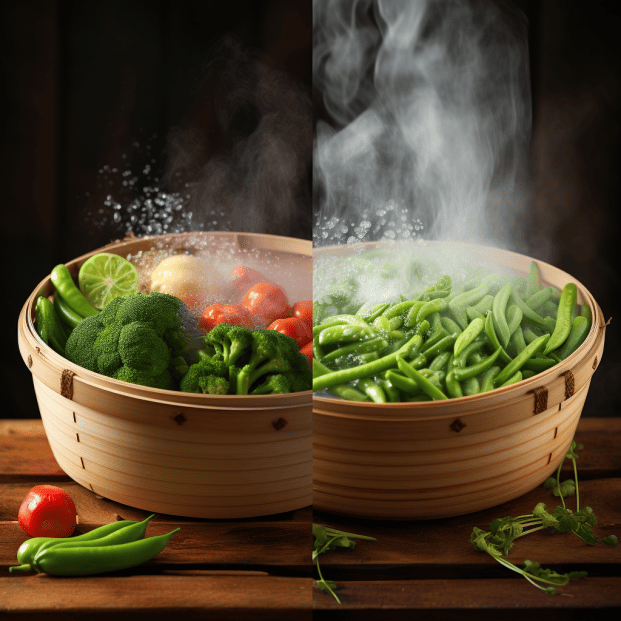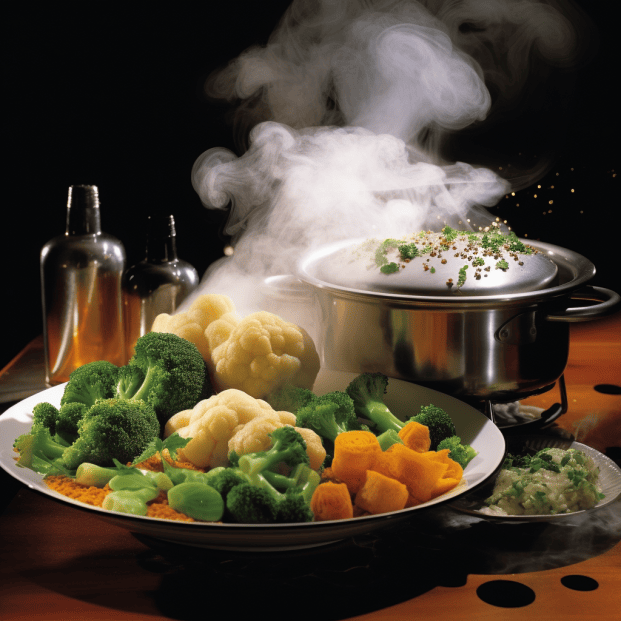Is it better to boil or steam your food? That’s the age-old question with no simple answer.
On the one hand, boiling is quick and easy – just like my friend Bill who can cook an egg in 10 seconds flat.
Although I’ve witnessed him set off the fire alarm a few too many times!
Steaming on the other hand requires a little more finesse, like that time I tried to steam broccoli and ended up with soggy green mush.
Bizarrely, my roommate still ate it with a smile!
In this guide, I’ll break down the pros and cons of boiling vs steaming so you can decide what’s best for your culinary creations.
By the end, you’ll know exactly how to bring out the best flavors in your vegetables, meat and more.
But you better pay attention because I don’t want you serving up another plate of mush!
KEY TAKEAWAY
Is it better to boil or steam food?
Boiling food may lead to nutrient loss due to leaching, while steaming helps retain more nutrients, making it a healthier cooking method. (1)
Healthier Cooking: Steaming vs Boiling
Many cooks wonder which method best retains food’s inherent nutrition.
Boiling submerges ingredients, yet steaming suspends above water, each imparting unique effects investigated.
Steaming penetrates food with high-heat vapor, rapidly elevating internal temperatures while limiting direct contact with cooking liquid.
This gentle approach often excels for more delicate morsels, minimizing nutrient seepage into water below.
Boiled foods release greater water-soluble nutrients like B vitamins and minerals into the simmering bath through osmotic processes.
While cooks may consume this nutrient-rich water, boiling requires discarding or further use whereas steaming’s liquid stays pure.
But, here’s the thing, there are some food which can’t be steamed, what are they? Read on the article to find out more information.
Nutritional Differences: Boiling vs Steaming

Several studies reviewed steaming cultivates higher vitamin, mineral and antioxidant retention than boiling. (2)
For each respective minute cooking, steaming rice retains 7% more nutrients than boiled.
Carrots lose 25% less vitamin C when steamed for 10 minutes versus boiled.
Simmering vegetables in water causes greater oxidation harming beneficial compounds.
Boiling also initiates greater texture and color change compared to the lighter touch of steaming.
However, thorough boiling deactivates potentially harmful microbes if concerns exist.
In either method, brief cooking times of 3-5 minutes maximize health advantages while maintaining pleasant textures.
Steaming in a basket suspends food out of direct contact with hot water, minimizing nutrients dissolving away for a lighter finish preserving natural flavors.
With proper application, both boiling and steaming serve nutritious preparations.
Yet for the utmost nutritional preservation of taste and appearance, steaming provides a slight edge making it perhaps the slightly healthier ordinary cooking method.
If you want to learn more about steaming and kitchen utensils for low sodium Chinese food, check out the article here.
Flavor Variations in Boiled and Steamed Food

The preparation process influences flavor profiles.
Boiling fully submerges foods in scented liquid, imparting robust tastes.
Steaming suspends ingredients above simmering water, allowing subtler seasoning seepage.
Dense vegetables like potatoes emerge from boiling water infused with richness from long contact.
Quick-cooked greens retains fresher natural savoriness with steaming’s outer-layer delicacy.
Meats like chicken and dumplings develop intense flavors boiled together in a savory broth base.
Steamed shellfish like crab impart lighter oceanic notes without direct cooking water immersion.
Drawbacks of Boiling Food: What to Be Aware Of
While an easy cooking method, boiling risks nutrient loss.
Long cooking exposes ingredients longer to oxygen, heat and water facilitating vitamin destruction.
Specifically, boiling draws out Water-soluble vitamins like C and B-complexes into the simmering liquid which gets discarded post-cooking versus steaming retain nutrients.
Overcooking turns vegetables to mush and leeches their bright hues, dulling both texture and visual appeal.
Boiling toughens or renders stringy certain meats like chicken if not handled precisely by the cook.
On the other hand, steaming with INTENSE pressure-cooked temperatures can overwhelm delicate foods if the scale tilts too far.
Proper steaming utilizes more horizontal space for consistent results across higher levels.
With practice selecting the suitable food items and cooking techniques, both methods shine.
Yet for nutrition, steaming maintains an edge making it the slightly healthier ordinary choice.
Steamed Food and Its Benefits for Weight Loss
While fad diets may promise drastic weight loss rapidly, they typically are not sustainable long-term and often result in weight gain down the road.
Maintaining a healthy lifestyle is best achieved through a balanced, nutritious whole foods diet composed of homemade meals.
Centuries ago, ancient Chinese medicine embraced the understated practice of steaming food.
By cooking with gentle steam instead of high heat methods, foods retain their nutritional value while keeping calories low.
Modern research has validated steaming’s ability to effectively nourish both physical and mental health.
Steaming locks in an abundance of crucial vitamins and minerals that can easily drain away during other cooking methods.
For example, Vitamin C, a powerful antioxidant, will stay inside green vegetables and fresh fruits when steamed instead of being lost in boiling water.
Steaming also allows the natural antioxidants in colorful plant foods like berries to remain with the food, granting the body their disease-fighting powers instead of releasing them into the cooking liquid.
Further, steaming cooks food without browning or scorching, practices linked to generating carcinogenic byproducts.
Cooking by steam maintains an item’s natural appearance and texture while bringing out its flavor through tenderized yet still intact fibers.
By retaining maximum nutritional value in a meal, steaming supports long-lasting fullness with fewer calories consumed.
This makes it an outstanding technique for healthy weight management.
Coupled with eating home-cooked whole foods instead of processed fare, a diet based around varieties of steamed superfoods effectively fuels the body and mind for both energy and hormones regulating appetite.
Steaming allows ordinary vegetables, grains and legumes to be prepared deliciously while optimizing one’s well-being, inside and out.
Tips for Savoring Steamed Delicacies
For light and robustly nourishing home meals, culinary experts at Food Network shared their techniques:
Use a steamer basket suspended above a pot of water to separate foods safely without sogginess.
Adjust water levels carefully beneath suspended trays to maintain steady wisps rather than boiling.
Speed cooking smaller diced pieces allows hot steam to permeate more swiftly while maintaining structure.
Baby spinach leaves require only a flutter to wilt perfectly.
Extra-virgin olive oil adds rich satisfying flavor to grains and greens in tiny amounts for anti-inflammatory support.
Cold pressed protects antioxidants.
Check water levels frequently to replenish evaporated steam without foods emerging from its healing mist.
Consistency sustains nutrition with condition maintained.
Vary cooking times for diverse items adjusted by thickness tested gently with a fork until tender but not broken down.
Gauging done-ness brings out sweet spots.
With mastery of steaming secrets, homes can easily provide balanced weight loss combined with lasting wellness through nature’s deliciously untouched whole foods.
Nourishment becomes accessible and joyous through this simple art of careful cooking with care of craft.
Expert Opinions: Is Steaming or Boiling Superior?
When preparing vegetables, both steaming and boiling are “moist-heat cooking techniques” commonly used.
However, each method affects nutrients differently.
As someone health-conscious seeking to maximize nourishment from home-cooked meals, understanding these cooking conditions empowers choosing techniques optimized for various foods.
Research from cooking studies finds steaming gently heats produce with water vapor, retaining more nutrients compared to boiling which uses simmering water.
Specifically, steaming broccoli retains higher levels of cancer-fighting antioxidants such as beta carotene versus cooking broccoli by conventional boiling or steaming methods.
The delicate process of steaming suspends foods above a cooking pot of water, preventing direct contact.
This protects water-soluble vitamins that might otherwise leach into boiling cooking liquid.
For example, studies show green cabbage steamed retains more of its immune-defending phytonutrients than cabbage boiled until tender.
Experts report boiling leaches out compounds from foods faster into the cooking liquid compared to steaming.
When boiling green beans or carrots, some minerals and vitamins dissolve away, reducing the meal’s healthy factor.
Steaming is a wiser choice for tender vegetables to keep their nutrition impact.
Meanwhile, for sturdier greens like kale and collard, boiling extracts more heart-helping flavonoids and cancer-fighting glucosinolates thanks to longer cooking.
So while steaming keeps more nutrients in the food itself, boiling a heartier leafy green creates a more nutritious combined pot of “liquid gold”.
In other words, the cooking mechanism matters greatly.
Steaming ensures the most nourishment stays with the food by gently heating with moisture without direct contact in water.
But boiling distributes nutrients between the food and cooking liquid, especially favoring heartier cuts.
Understanding these distinctions enlightens home chefs in optimizing meals to power health.
Choosing the Right Cooking Method for Different Foods
To leverage kitchen skills nourishing the whole body and mind, consider these guidelines:
- Steaming works best for delicate vegetables like broccoli, green beans and cabbage to keep crunchy textures and concentrate nutrients in the food.
- To extract maximum nutrition for hearty kale, collards and Swiss chard, boiling allows flavonoids and glucosinolates to infuse not just the leaves but the cooking liquid.
- When using cooking oils is unavoidable for foods like artichokes, choose cold-pressed varieties like olive oil shown to remain heat-stable and not form toxic compounds.
- Stir-frying with minimal cooking oils gets produced on the table faster while maintaining nutrients through quick, high-heat cooking times.
Staying flexible to complement one’s palate with power-packed prepared produce unleashes healthier baking and recipes. Understanding food science creates tastier means nourishing entire communities.
Conclusion
In conclusion, both boiling and steaming can be excellent cooking methods depending on your ingredients and desired results.
Boiling is a quick way to fully submerge foods for fast cooking.
While steaming gently coaxes out nutrients and flavors while keeping items moist.
With some practice, you’ll be an expert in the kitchen regardless of your cooking style.
Don’t be afraid to get creative and try new preparation methods.
And most of all, remember cooking is about enjoying the process as much as the results.
Now get in there and start boiling or steaming to your heart’s content! Let me know if you have any other culinary conundrums come up.
References
- https://www.theguardian.com/food/2023/may/02/is-it-better-nutritionally-to-boil-or-steam-vegetables-kitchen-aide#:~:text=%E2%80%9CSteaming%20allows%20you%20to%20retain,with%20a%20pesto%20or%20tahini.%E2%80%9D
- https://www.ncbi.nlm.nih.gov/pmc/articles/PMC4973943/
Related Articles
- https://bowlakechinese.com/low-sodium-chinese-food-products/
- https://bowlakechinese.com/steaming/
- https://bowlakechinese.com/what-foods-cant-be-steamed/
Was this helpful?

I am a skilled chef assistant with a passion for Asian cuisine, I have honed my craft through formal training at At-Sunrice GlobalChef Academy and years of experience in the culinary industry. I have extensive knowledge of cooking techniques and herbs and spices, with a particular focus on traditional Chinese dishes. I’m also an author of the book “Delicious Keto Low Carb Chinese Food for Busy Moms and Fitness Enthusiasts” which is sold on Amazon. On my blog, bowlakechinese.com, I share my expertise in Asian cuisine and provide tips and recipes for those interested in low carb Chinese cuisine.

